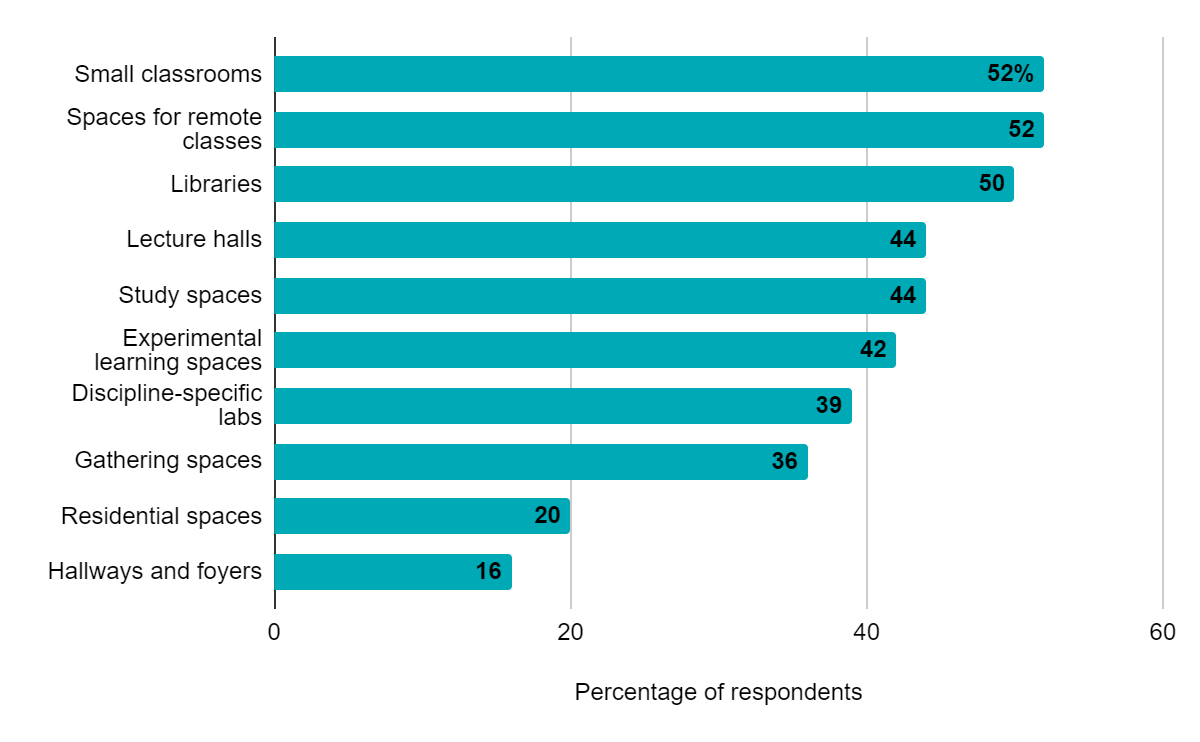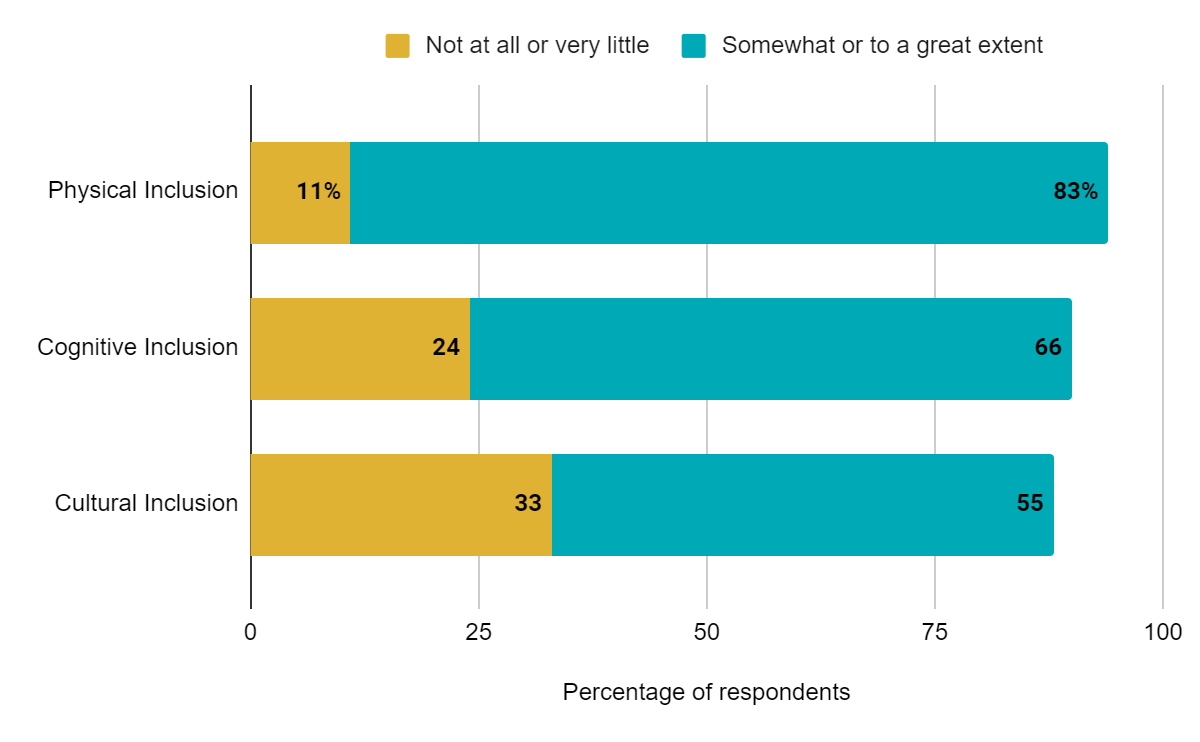The transformation of learning spaces is ubiquitous among higher education institutions. IT leaders can provide essential support for driving transformation toward more inclusive and effective learning spaces on their campuses.

EDUCAUSE is helping institutional leaders, IT professionals, and other staff address their pressing challenges by gathering and sharing data. This report is based on an EDUCAUSE QuickPoll. QuickPolls enable us to rapidly gather, analyze, and share input from our community about specific emerging topics.Footnote1
The Challenge
As the nature of higher education evolves rapidly, conversations about "the new normal" are raising questions about the future of physical learning spaces. Higher education officials are returning to pre-pandemic learning spaces projects, often with questions about how those spaces will be used in a post-pandemic world. The need will remain for general purpose classrooms, libraries, lecture halls, and study spaces, but how might an increased focus on remote modalities and inclusive learning environments impact the nature of learning spaces on campus? The challenge for IT leaders is to address current institutional needs while considering what stakeholders will need in the future.
The Bottom Line
The only constant in higher education technology is change. One hundred percent of respondents to this QuickPoll indicated that at least one type of learning space at their institutions is undergoing transformation. With an eye toward the future, IT units can help institutions create inclusive, flexible spaces that support a variety of learning activities and modalities. Appropriate technology infrastructure, strategic support from institutional leaders, and financial resources are among the most essential elements for transforming learning spaces. To support these efforts, IT leaders can take the following actions:
- Engage directly with learning spaces staff at your institution as partners in strategic and financial planning.
- Provide leadership for learning spaces projects, especially in cases where strategic vision is lacking.
- Consider your institution's plans for the future and whether remote learning and work will play a significant role in your "new normal."
- Provide staff with resources to gain the knowledge and skills they need to support inclusive learning spaces.
The Data: Transforming Learning Spaces
Institutions are transforming multiple types of spaces. Over a third of respondents (36%) indicated that leaders at their institutions are actively working to transform (and not merely maintain) five or more types of learning spaces, and 100% of respondents reported that at least one type of learning space is being transformed. Respondents most frequently identified small classrooms (52%), spaces for connecting to synchronous remote classes (52%), and libraries (50%) as the spaces being transformed (see figure 1). Informal learning spaces such as residential spaces (20%) and hallways and foyers (16%) ranked lowest among the options provided. One in ten respondents indicated that other types of spaces, including maker spaces, computer labs, and active learning classrooms, are slated for transformation.

Learning spaces work is supported by institutional goals. We asked about the top three enablers or supports of learning spaces transformation. Nearly half of respondents (47%) reported that spaces are being modified to support remote or hybrid learning. Almost a third reported that their work in transforming learning spaces is supported by:
- the availability of appropriate technology infrastructure for supporting learning spaces (32%);
- strategic and operational support from institutional leadership (31%);
- the availability of financial resources for building, transforming, maintaining, and continuously improving learning spaces (31%); or
- the alignment of learning spaces work (e.g., planning, operation) with institutional strategic plans (29%).
None of the respondents selected either conducting or disseminating learning spaces research as one of the top three enablers of learning spaces transformation at their institution. Other low-ranking enablers were support for inclusive space design (10%), available professional development for learning spaces staff (9%), and a room reservation system that matches spaces to pedagogical needs (8%).
You either have it or you don't. The same resources identified as enablers of transformation by some respondents acted as barriers for others when those resources are in short supply. For example, 45% of respondents identified the need to secure financial resources as one of the three biggest challenges related to transforming learning spaces at their institutions. The need for support from institutional leadership (24%) trailed far behind as a distant second, closely followed by several other challenges:
- Gaining support from faculty (23%)
- Developing a room reservation system that matches spaces to pedagogical needs (23%)
- Aligning learning spaces work with institutional strategic plans (22%)
- Providing professional development and course redesign support for faculty (21%)
- Designing inclusive spaces (21%)
- Finding resources to pilot and prototype new ideas for learning spaces (20%)
- Conducting learning spaces research and assessment (20%)
The Data: Hybrid Learning Spaces
Supporting hybrid learning spaces will require technology and personnel support. Two in five respondents (40%) reported that their institutional strategic plans include providing support for hybrid courses after the pandemic. When asked how their institutional leaders plan to modify classroom design and operational support for the purpose of supporting hybrid courses, most respondents focused on changes in technology:
"We plan to include camera(s) in classrooms along with mics for easy sharing."
"We are installing additional AV equipment in classrooms to support hybrid learning in more spaces."
"Upgrade all centrally scheduled classrooms to a fully enabled 'technology classroom' with automated lecture recording, multi-screen/split projection, enhanced sound and lighting."
Some respondents also described personnel support and collaboration:
"Provide in-class technical assistance for the faculty."
"Planning faculty development sessions, and onboarding additional support staff."
"[There are] multiple committees charged to provide strategic direction on this front."
Supporting hybrid learning spaces brings more (of the same) challenges. We also asked respondents to describe the biggest challenge related to modifying spaces to support remote or hybrid learning. A large proportion of respondents described funding challenges:
"Financing, especially at the scale to integrate technology successfully. There's a difference between someone being able to pump [video and audio] to a Zoom call (simple) and having the proper microphone setup, screens, hardware, infrastructure, and interface to allow for high-quality and easy-to-use synchronous Zoom meetings with face-to-face students and remote learners."
Respondents also described challenges related to institutional culture, leadership, and faculty buy-in:
"Due to some negative connotations, we have some leaders who say we will not offer hybrid modalities."
"Faculty [not] embracing the technologies and the concepts of remote and hybrid learning."
"Lack of a clear definition of who is responsible."
Finally, respondents explained that standardizing hybrid learning space design is challenging:
"The variety of our spaces almost demands a bespoke approach be taken for each of them."
"Many of our learning spaces are managed locally so standardizing can be challenging."
The Data: Inclusive Learning Spaces
Not all types of inclusion are considered in learning space design. Respondents rated the extent to which three types of inclusive design elements are considered in the design and support of learning spaces at their institutions (see figure 2). Definitions for these types of inclusion have been modified from version three of the Learning Space Rating System (LSRS):
- Physical Inclusion: In addition to meeting the accessibility guidelines required by law (e.g., ADA), the learning space is physically accessible for all faculty, students, and staff.
- Cognitive Inclusion: A range of teaching and learning modalities is available to accommodate learners' variable ways of receiving information, engaging with learning environments, and expressing knowledge.
- Cultural Inclusion: The learning space is comfortable and welcoming, contributing to a shared sense of dignity, respect, and community and affirmatively reflecting the community's diverse cultural backgrounds.
More than four in five respondents (83%) indicated that physical inclusion is taken into consideration either "somewhat" or "to a great extent" at their institutions. Cognitive (66%) and cultural inclusion (55%) are considered to a lesser extent. Respondents offered a possible explanation:
"Knowledge. Physical inclusion is fairly straightforward, cognitive and cultural less so."
"Evidence-based research on [being] cognitively and culturally inclusive is sparse at best."

Change requires funding, cultural change, and knowledge of best practices. Respondents described their biggest challenges related to making their institution's learning spaces more inclusive. Again, respondents described budgetary constraints:
"One of our challenges is designing rooms that meet the needs and expectations of all learners while not breaking the bank. We really can't afford to implement a full innovative design to 200 classrooms, so we have to determine what works best and is within our means while also meeting the goals of remote students."
Another common challenge is institutional culture:
"I think we look at space with too much of a top-down perspective. We survey faculty on their needs, but not students. Therefore we don't put enough emphasis on how the changing student culture is (or should) drive the institutional culture."
"Faculty buy-in. Faculty can choose whether or not to learn about and make efforts towards providing inclusion. Some do, many don't."
Finally, respondents expressed that knowledge of best practices can be lacking:
"Not sure how to design learning spaces through a diversity, equity, inclusion lens."
"The people who understand how to make spaces more inclusive are not usually at the table when space design is happening."
Common Challenges
Funding and strategy have a reciprocal relationship, and both are needed. One respondent indicated that "understanding all of the requests and determining which to prioritize" is a challenge. Another respondent identified "leadership lack of understanding of the importance to make this a priority and part of the strategic framework." Strategy dictates prioritization, and prioritization dictates funding: "It always comes back to money (meaning, priorities because there's always money for other things that never end)."
Faculty support is not easily won. Support from faculty was one of the most selected challenges among respondents. Instructional activities and learning spaces functionality are interconnected.Footnote2 Interestingly, only one respondent mentioned eliciting student feedback in learning space design, even though students spend more time than any other stakeholder in learning spaces. How might faculty buy-in change if faculty and students are included as subject-matter experts?
Promising Practices
Lead with equity. Many respondents indicated that knowing how to create environments that integrate multiple types of inclusion is challenging. Professionals who specialize in instructional design might be the best resource institutions have for considering ways to make spaces inclusive.Footnote3 There are also associations and centers that provide resources for designing inclusive environments, such as the Flexible Learning Environments Exchange (FLEXspace) and the Center for Inclusive Design and Environmental Access (IDEA) at the University of Buffalo. Nearly a quarter (23%) of respondents reported that they have previously used the LSRS, which is an in-depth resource for stakeholders to evaluate and improve learning spaces on their campuses and contains a section dedicated to inclusion.
Consider the future of learning modalities. Nearly half of respondents indicated that at their institutions, learning spaces are being modified to support hybrid learning. A mix of physical and remote learning is anticipated to be essential to the future of higher education.Footnote4 Certainly, supporting spaces for hybrid learning comes with its own set of challenges, such as budgetary constraints and designing for inclusion.Footnote5 Keep an eye out later this month for the EDUCAUSE Showcase The Digital versus Brick-and-Mortar Balancing Game and the 2022 teaching and learning edition of the EDUCAUSE Horizon Report, which will provide insights and resources for institutions shifting toward remote modalities.
All QuickPoll results can be found on the EDUCAUSE QuickPolls web page. For more information and analysis about higher education IT research and data, please visit the EDUCAUSE Review EDUCAUSE Research Notes topic channel, as well as the EDUCAUSE Research web page.
Notes
- QuickPolls are less formal than EDUCAUSE survey research. They gather data in a single day instead of over several weeks and allow timely reporting of current issues. This poll was conducted between March 28 and March 29, 2022, consisted of 13 questions, and resulted in 154 responses. The poll was distributed by EDUCAUSE staff to relevant EDUCAUSE Community Groups rather than via our enterprise survey infrastructure, and we are not able to associate responses with specific institutions. Our sample represents a range of institution types and FTE sizes. Jump back to footnote 1 in the text.
- Jodie Penrod, "The Impact of Learning Space Design on Learner Experience and Collaboration," EDUCAUSE Review, November 17, 2021. Jump back to footnote 2 in the text.
- Chris Gamrat, Sonia Tiwari, and Saliha Ozkan Bekiroglu, "INCLUSIVE ADDIE: Initial Considerations for DEI Pedagogy," EDUCAUSE Review, March 10, 2022. Jump back to footnote 3 in the text.
- Jodie Penrod, "Staying Relevant: The Importance of Incorporating HyFlex Learning into Higher Education Strategy," EDUCAUSE Review, March 25, 2022. Jump back to footnote 4 in the text.
- Patricia Turner, "Revisiting Camera Use in Live Remote Teaching: Considerations for Learning and Equity," EDUCAUSE Review, March 14, 2022. Jump back to footnote 5 in the text.
Jenay Robert is Researcher at EDUCAUSE.
© 2022 Jenay Robert. The text of this work is licensed under a Creative Commons BY-NC-ND 4.0 International License.
